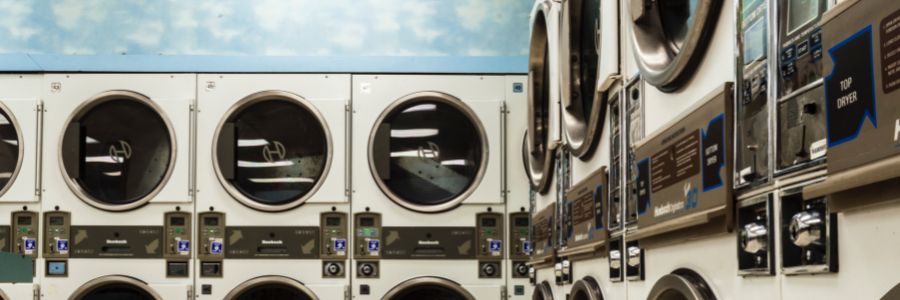Elon is a marketing specialist at Palo Alto Software, working with consultants, accountants, business instructors and others who use LivePlan at scale. He has a bachelor's degree in journalism and an MBA from the University of Oregon.
How to Write a Laundromat Business Plan + Example Templates

7 min. read
Updated February 7, 2024
Would you open a business in an industry that continuously sees annual growth rates between 3 and 5 percent, with steady growth forecast for the next decade?
Starting a laundromat business may not sound flashy, but it has proven to be a profitable venture for many.
But just like a retail store or tech startup, operating a successful laundromat business takes careful planning. It also requires accounting for major upfront costs, and keeping in compliance with environmental regulations.
That’s why it’s so important to conduct extensive research and planning, before investing in building space and expensive commercial-grade laundry equipment. Putting together a solid business plan will help you focus on the important purchases to make and processes to implement to run a successful laundromat business.
Get started by downloading our free sample laundromat business plan template.
Why You Need a Business Plan for Your Laundromat Business
Because of the careful planning and attention to details required, it’s crucial to map out the vision and structure for your business. That’s where a business plan comes in handy.
Do you know how much you will need to spend on equipment before you ever bring in any revenue? Will you need a bank loan to get up and running? Most customers look for the laundromat that’s closest to them, so how much do you know about the demographics of the neighborhood you plan to operate in?
A business plan is the place to compile your most relevant market research, financial projections, and your overall strategic vision for the business. It’s where you can document assumptions about your startup costs and ongoing operational costs, as well as the processes you’ll put in place to ensure compliance with environmental rules.
This guide will help you structure your laundromat business plan, detailing the main areas to cover in the plan and what types of information you’ll need to compile.
Understand Your Business Model and Startup Costs
All laundromats are not the same. There are the traditional, coin-operated models. But there are also more modern card-operated systems. Many are self-service, but some provide drop-off service, dry clearing, even tailoring. In your business plan, you should discuss the laundromat business model you are choosing and why. Higher-end services like tailoring might attract a broader customer base, but they bring additional costs.
Your business plan is the place to define the services you will provide. It’s important to document these decisions, even if you are just opting for a traditional coin-operated laundromat. Producing a detailed estimation of your startup costs before launching the business is essential, since it will ensure you are considering the full range of equipment and utility costs.
Once you have defined your business model, you will need to show that it aligns with your projected costs, including:
- Building lease or purchase
- Renovations
- Commercial-grade laundry equipment
- Laundry detergent
- Utilities
- Insurance
- Business license
Without detailing your startup costs upfront, your financial projections for the business won’t be accurate, and you will be less prepared for unexpected costs.
A detailed financial projection will also help you determine how long it will take for your business to break even. With a detailed description of your business model and startup costs, you will be ready to approach lenders or investors to get funding for your laundromat. That initial investment will be key to your success, since laundromat startup costs are often hundreds of thousands of dollars.
Know the Area You’ll Serve
Location, location, location. It’s true for many businesses that the location it operates in plays a major role in determining how many customers walk through its doors. That’s especially true for a laundromat. Many customers will be apartment tenants, and are likely to seek out a laundromat within 1-3 miles of where they live.
So the location of your laundromat is a significant determinant of its potential success, and should be a focal point in your business plan. A strategic location can drive high foot traffic, increase visibility, and ultimately boost revenue.
Your selected location should ideally be in an area with a high density of potential customers. This could include neighborhoods with many apartments or near university dormitories where residents may not have easy access to laundry facilities. Additionally, your location should be easily accessible, preferably on a main road with clear visibility from the street to attract passers-by.
In your business plan, explain why your chosen location meets these criteria. Describe the following:
- Demographics of the area
- Ease of access to the business
- Parking
- Visibility from the street
- Competitors and their distance from your business
While marketing may not be a huge portion of your operating budget, you will want to demonstrate in your business plan that you have a strategy for acquiring customers and retaining them. Consider strategies you might use to promote your business, like advertising through flyers and newspaper ads, or digital marketing on social media or through search engine optimization.
Understanding your target customers will help inform these strategies. For instance, if your laundromat is near residential areas or college campuses, you may want to advertise in student publications or on social media channels. But if it’s in the middle of a busy downtown, you may want to advertise cleaning services for suits, or commercial laundry services.
Stay on Top of Operating Expenses
We’ve discussed the sizable costs to open a laundromat business. But there are also ongoing operational costs that need to be taken into account. Think about a washing machine that’s broken down, dryer lint screens that need to be replaced, or maintenance on your water connections.
Your business plan is where to compile those costs, since they’ll have a significant impact on your long-term finances. You won’t be able to accurately estimate your break even date without them.
Your business plan must detail the maintenance and repair strategies you intend to employ in order to extend the life of your equipment. Document your strategy for handling repairs – whether you’ll use an on-call technician, train any staff to handle minor upkeep, or send faulty equipment to the manufacturer for repairs.
You should also state whether you will have a contingency plan while machines are being repaired. Do you have spare machines, or a regular maintenance schedule to minimize disruption? This will show potential lenders or investors that you’ve considered steps to maintain steady revenue streams.
Don’t forget about utility and insurance costs, as well. These are ongoing expenses that can change as your business grows. You will want to demonstrate in your business plan that you have considered the impact of these costs on your business – not just when you start the business, but on an ongoing basis.
Compliance Can Make or Break Your Business
Laundromats are subject to a variety of regulations, from local zoning laws to environmental standards. For instance, there might be specific requirements for wastewater disposal, given the amount of detergents and chemicals laundromats typically use. You may also need to comply with safety standards regarding equipment operation and maintenance.
It’s crucial to comply with all relevant regulations, just as in any business. Your business plan should include a section dedicated to detailing these legal and regulatory requirements.
Start by identifying the agencies that oversee these regulations, from local health departments to the Occupational Safety and Health Administration and Environmental Protection Agency. List the concerns these agencies will be looking out for, from wastewater disposal to emissions from your laundry machines. Then, detail the steps you’ll take to ensure compliance, such as regular inspections and audits, staff training and the implementation of safety protocols.
Show customers and your lender that you know about the relevant regulations and have a plan to stay on top of them. Not only will it reassure them that you can responsibly run a laundromat business, but it also reduces the risk of costly fines, operational disruptions and even lawsuits.
Download a free laundromat business plan template and example
For help getting your business started, download our free laundromat business plan template. You can download this document in Word form and use it as a foundation for your own business plan.
If you want to brush up on how to write specific sections of a traditional business plan, take a look at our step-by-step guide on how to write a business plan.
Brought to you by
Create a professional business plan
Using AI and step-by-step instructions
Create Your PlanSecure funding
Validate ideas
Build a strategy








